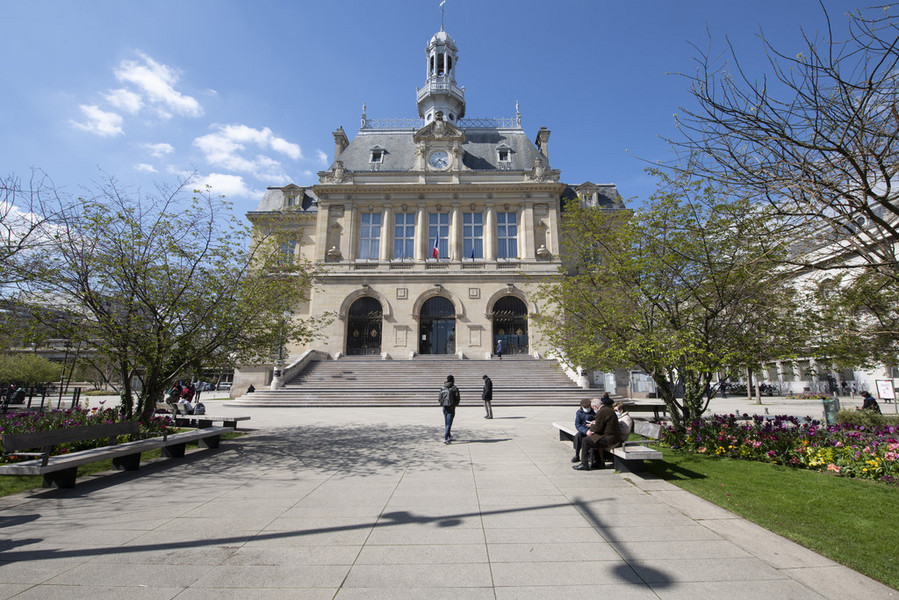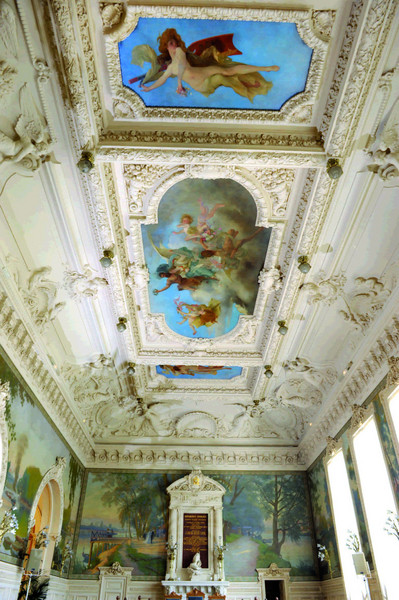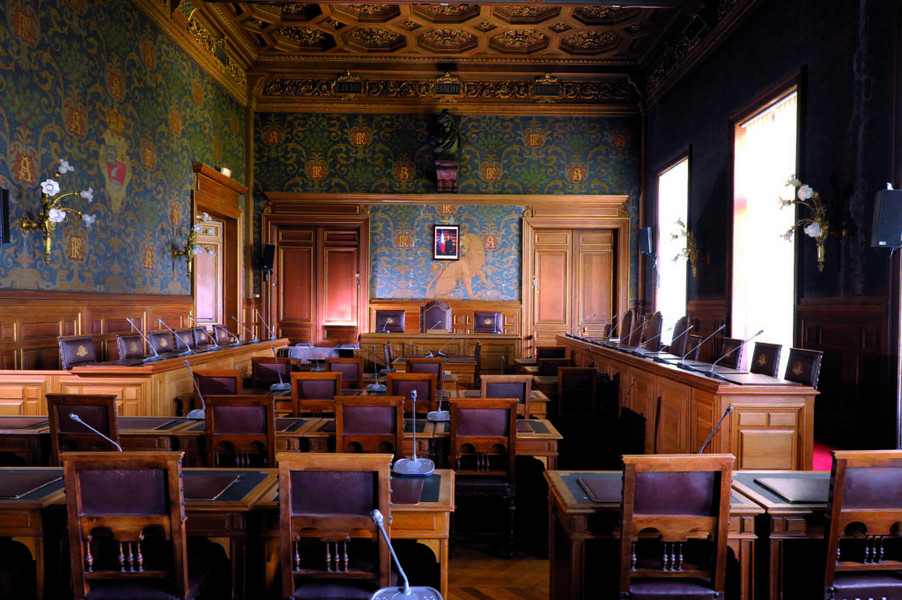

The Town Hall

Until 1822, there was no communal building (or town hall) in Asnières, and the Local Council met at the homes of successive mayors. On 12 August 1822, the town bought the former presbytery and a "room completely isolated from the pastor's home was converted into a community house". On 23 July 1845, when the presbytery was being rebuilt, the Local Council decided to "temporarily move the Town Hall and its archives to one of the old school houses".
Ownership of this dilapidated old house, which accommodated the beadle, was disputed by the Church and the Commune, who agreed to an official division before a notary on 12 and 15 June 1847.
Around 1935, the premises that had served as the temporary town hall, located at no. 13 rue de l'Église, were demolished along with the surrounding houses to enlarge the square.
On 4 November 1849, the Local Council took up residence opposite No. 10, in a building completed on 4 April 1839 on the site of the former cemetery, Place de l'Église, which had previously served as the municipal school.
This building, demolished around 1929, housed the Town's administrative offices from 1849 to 1875. In 1875, the Town of Asnières purchased the former property of Mr Vanin de Courville, a former magistrate, and the municipal services moved into the large house dating from the previous century. The offices were cramped, despite being refurbished in 1893.
Past and Present
On 15 April 1895, an architectural competition was held at the Paris City Hall. 57 candidates took part and on 13 August, the design by Emmanuel Garnier, a 33-year-old architect and former student of the Ecole des Beaux-arts, was chosen.
Ground was broken on 25 July 1897, and on 10 October the following year, Mr de Selves, Prefect of the Seine, laid the first stone "in the midst of a huge public turnout". During the summer of 1899, the buildings of the old town hall were demolished, and the new town hall was inaugurated on 15 October 1899.
The Hall and the Grand Staircase
On the second floor, a central gallery, in line with the Grand Staircase and illuminated by 3 domes magnificently decorated by the sculptor Margotin (famous for the sculptural decoration of the City Hall of the 10th arrondissement of Paris), separates and serves the proceedings chamber of the Local Council and the wedding hall, both of which are remarkable... The decorations in this room are truly magnificent. They are the work of the sculptors Romain Chevré, father and son.
In the monumental entrance lobby, the mosaic is made up of 600,000 marble squares, each 20 millimetres square. Voillaume, the company responsible for the mosaic, had special machines built to cut them.
The gallery and the wedding hall
On 20 December, the Conseil Général de la Seine decided to launch a competition "for the artistic decoration, at its own expense, of the reception room of the Town Hall of Asnières".
The artists were asked to "draw their inspiration from views taken exclusively in the region of Asnières".
114 candidates submitted their sketches to the Paris City Hall on 10 December 1900. They included Paul Signac, whose participation was demonstrated by a set of four panels, as well as Dufy, Friesz, and the Douanier Rousseau. On 17 June 1901, Henri Bouvet (b. 1859), a painter from Marseille, won the competition to decorate the wedding hall, which was completed on 2 March 1904.
Until 1935, the Reception and Wedding Hall was the venue for major cultural events and balls organised by the Town Hall, in particular those of the Charity Office.
After the creation of a "grand ballroom" in the administrative and social centre, which was converted into a "grand theatre" in 1980, the Town Hall continued to host banquets and receptions for various personalities (Georges Bidault in 1951, Georges Pompidou in 1963 or André Malraux in 1974, etc.), the awarding of decorations and certain conferences or concerts in its various rooms (wedding hall and mayor's office).
More recently, the Town Hall has undergone major renovations (the facades in 1989, the entrance lobby in 1990, and the wedding hall in 1992).
Behind the lacquered wooden podium, commissioned from the cabinet maker Préau in 1901, a bride and groom are strolling along the Ile de la Grande Jatte.
In the background, the railway bridge can be seen in the distance, obscuring the road bridge.
The set consists of 4 panels depicting the banks of the Seine at Asnières and the surrounding area.
On the right, framed by 5 large windows, the artist has chosen to depict Île des Ravageurs, and in particular the entrance to the Dog Cemetery (opened in 1899), near the Clichy bridge.
At the other end of the room, the port of Clichy and the cranes of the gas works provide a backdrop for the coal unloaders and the conversations of the women on board the barges. You can also see the Asnières bridge, Île Robinson and Île des Ravageurs.
On the left, around 3 arcades leading to the gallery on the second floor, the view unfolds on the Asnières quay and its passers-by, upstream of the Clichy bridge and the two islands.
Barges towed by a tugboat move on the water.
On the ceiling, the painter Henri Courcelles-Dumont has chosen to depict graceful allegories in rich colours.

The Council Chamber

The sculptures in the local council chamber were made by M. Raynaud, who was also responsible for the sculptures and decorations in the town hall of Levallois-Perret.
The pictorial decorations are the work of Henri Lacouture, a painter from Asnières (born in 1841), who restored the decorations in the Sainte-Chapelle...
These panels were painted around 1900.
The Mayor's Office
All that remains of the mayor's office of 1901 is the large ministerial desk with pilasters carved in solid walnut and decorated with the town's coat of arms (supplied by the Maison Balman et Bignand, 6 rue de Lyon, Paris) and the matching wooden armchair.
The mayor's office was completely refurbished at the beginning of Michel Maurice-Bokanowski's first term of office by interior designer Pierre Cruège.
The "Bateau lavoir Armand", painted by Alexandre Jacob and acquired to decorate the mayor's office, is currently in the Jean-Claude Boutiffard salon.
The memorial
Cruelly scarred by the war of 1870, the town of Asnières erected, at the beginning of the 20th century, a monument to the dead, also dedicated to the victims of the Crimean War, fought in 1854-1855 against Tsar Nicholas the First.
The uplifting image seems to be inspired by sacred iconography: a dying soldier supported by the motherland, which gives him the flag as his supreme hope.
The memorial was sculpted by Auguste Maillart and erected by public subscription on the initiative of Laurent Cély, general councillor. It was unveiled on 28 July 1901.
Auguste Maillart was also the sculptor of the bronze bust of Marianne in the Town Hall.
